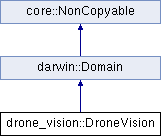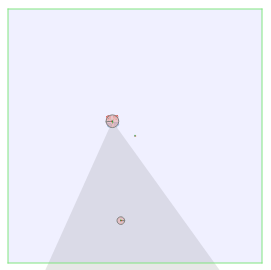Domain: Drone Vision. More...
#include <domain.h>
Inheritance diagram for drone_vision::DroneVision:

Public Member Functions | |
| size_t | inputs () const override |
| Number of inputs to a Brain. | |
| size_t | outputs () const override |
| Number of outputs from a Brain. | |
| bool | evaluatePopulation (darwin::Population *population) const override |
| Assigns fitness values to every genotype. More... | |
 Public Member Functions inherited from darwin::Domain Public Member Functions inherited from darwin::Domain | |
| virtual unique_ptr< core::PropertySet > | calibrateGenotype ([[maybe_unused]] const Genotype *genotype) const |
| Optional: additional fitness metrics (normally not used in the population evaluation, ie a test set) | |
Detailed Description
Domain: Drone Vision.
A simple vision test: look at the red ball, using only the camera pixels as input. The target ball starts moving in a random direction and will bounce off the walls.

Inputs
The inputs are the color channels from the drone's camera, plus optionally the depth channel.
Outputs
| Output | Value |
|---|---|
| 0,1 | force vector (x, y) applied to the drone |
| 2 | torque applied to turn the drone |
Member Function Documentation
◆ evaluatePopulation()
|
overridevirtual |
Assigns fitness values to every genotype.
Having a good fitness function is a key part of evolutionary algorithms:
- Perhaps obvious, the fitness value should accurately estimate the quality of a particular solution
- A "smooth" distribution is preferable since it provides a gradient which can guide the incremental search in the solutions space. (ex. if most fitness values are 1.0 or 0.0 it's hard to know which genotypes are good candidates for reproduction)
- Returns
trueif the evolution goal was reached
Implements darwin::Domain.
The documentation for this class was generated from the following files:
- C:/Users/lemo/work/darwin/domains/drone_vision/domain.h
- C:/Users/lemo/work/darwin/domains/drone_vision/domain.cpp
 1.8.14
1.8.14